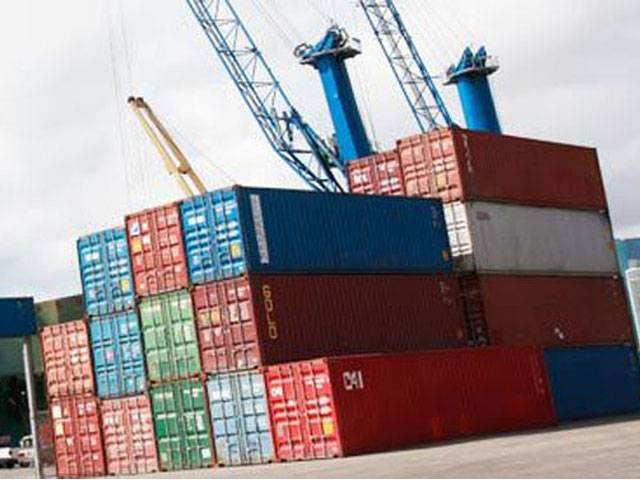ISLAMABAD - Pakistan’s trade deficit has contracted by over five percent during first quarter (July to September) of the current financial year 2013-14 as exports outpaced the anemic growth in imports, which reduces the pressure on country’s foreign exchange reserves.
The country’s trade imbalance has narrowed to $4.465 billion during first quarter (July to September) of the ongoing fiscal year 2013-14 against $4.708 billion of the corresponding period of previous year, showing a decline of 5.15 percent in one year. The main reason behind shrunk trade deficit is that exports have grown slightly faster than imports during first quarter (July to September) of the current financial year 2013-14.
According to the latest figures released by Pakistan Bureau of Statistics (PBS), the country’s exports grew 9.23 percent in July to September period of the fiscal to $6.712 billion as against $6.145 billion of the goods exported in the corresponding three months of the last fiscal year. Imports in the period grew three percentages point to $11.177 billion in first quarter of the present financial year compared to $10.853 billion of the corresponding period of previous year. As imports fell far behind the growth in exports, the trade deficit contracted 5.15 percent in the first three months of the fiscal 2014.
The reduction in country’s trade deficit would provide little relief to the country’s foreign exchange reserves, which are sharply depleting due to repayment to International Monetary Fund (IMF). The latest figures of State Bank of Pakistan (SBP) revealed that country’s foreign exchange reserves reduced to $9.128 billion wherein SBP’s held reserves stood at $3.953 billion.
Pakistan and IMF have estimated that country’s exports would grow by 11.4 percent against the imports of seven percent during the ongoing fiscal year. Pakistan and IMF projected that current account deficit would be 0.6 percent of the GDP during current financial year. If the current account deficit widens far more than the projected level, it will create problems for the SBP to fulfil its commitments to the IMF. The central bank will face problems in maintaining an agreed foreign currency reserves level in addition to achieving quarterly targets of net foreign assets. The SBP already missed the benchmark level of foreign exchange reserves, as under the IMF programme, it was agreed that the gross official currency reserves held by SBP would be standing at $5.6 billion on September 30, 2013 but it reduced to $4.6 billion on the same date, indicating a shortfall of $1 billion contrary to the envisaged benchmark.
According to the PBS figures, the overall exports have increased by 31.37 percent in the month of September against August. The country’s exports have recorded at $2.622 billion in September as against $1.996 billion of August. Meanwhile, the imports have registered growth of 6.15 percent during September against August. The country’s imports bill has recorded at $3.791 billion in September against $3572 billion of August. Therefore, the country’s trade imbalance decreased by 25.78 percent in September 2013. The country’s trade deficit was recoded at $1.170 September 2013 against $1.576 billion of August 2013.
Meanwhile, according to the PBS figures, exports stood at $2.622 billion in September 2013, which were $2.199 billion in September 2012 and this showed an increase of 19.22 percent in exports in one year. Meanwhile, imports have enhanced by 8.14 percent and were recorded at $3.791 billion in September 2013 against $3.506 billion of September 2012. The trade deficit for September 2013 against September 2012 narrowed by 10.49 percent and was recorded at $1.170 billion.
Saturday, April 20, 2024
Trade deficit shrank 5.15pc in 1Q
Trade imbalance narrowed to $4.465b during Jul-Sept of ongoing fiscal year against $4.708 billion last year

5:19 PM | April 19, 2024
8:09 AM | April 19, 2024
Pak economy improving, funds will be provided on request: IMF
9:57 PM | April 19, 2024
Minister advocates for IT growth with public-private collaboration
9:57 PM | April 19, 2024
Judges' letter: IHC seeks suggestions from all judges
9:55 PM | April 19, 2024
Formula 1 returns to China for Round 5
9:05 PM | April 19, 2024
Germany head coach Julian Nagelsmann extends contract till 2026 World Cup
9:00 PM | April 19, 2024
A Tense Neighbourhood
April 19, 2024
Dubai Underwater
April 19, 2024
X Debate Continues
April 19, 2024
Hepatitis Challenge
April 18, 2024
IMF Predictions
April 18, 2024
Kite tragedy
April 19, 2024
Discipline dilemma
April 19, 2024
Urgent plea
April 19, 2024
Justice denied
April 18, 2024
AI dilemmas unveiled
April 18, 2024
ePaper - Nawaiwaqt
Advertisement
Nawaiwaqt Group | Copyright © 2024





